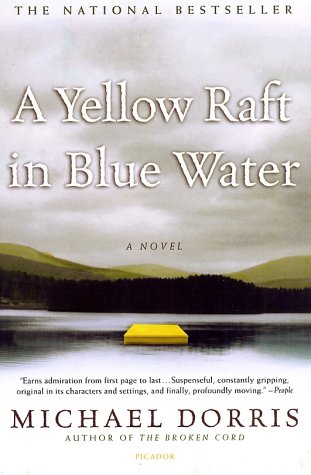All Nonfiction
- Bullying
- Books
- Academic
- Author Interviews
- Celebrity interviews
- College Articles
- College Essays
- Educator of the Year
- Heroes
- Interviews
- Memoir
- Personal Experience
- Sports
- Travel & Culture
All Opinions
- Bullying
- Current Events / Politics
- Discrimination
- Drugs / Alcohol / Smoking
- Entertainment / Celebrities
- Environment
- Love / Relationships
- Movies / Music / TV
- Pop Culture / Trends
- School / College
- Social Issues / Civics
- Spirituality / Religion
- Sports / Hobbies
All Hot Topics
- Bullying
- Community Service
- Environment
- Health
- Letters to the Editor
- Pride & Prejudice
- What Matters
- Back
Summer Guide
- Program Links
- Program Reviews
- Back
College Guide
- College Links
- College Reviews
- College Essays
- College Articles
- Back
A Yellow Raft in Blue Water
A Yellow Raft in Blue Water is a story carefully written by Michael Dorris that tells the gripping tale of a multi-generational family of women. It exposes the challenges of living on an Indian reservation, but it dives even deeper into the inner workings of a truly dysfunctional family.
The eldest female, named Ida, tells her children to call her “Aunt Ida” and has a personality that is raw and unfinished. She shatters the typical stereotype for a grandmother and comes across as very unconcerned and restrained. While she always provides for her daughter, Christine, and her son Lee, she appears to be hostile. Christine is a daring character who cares nothing about the consequences of her actions and conceives Rayona with a man named Elgin. Rayona is naïve and struggles to find her personality as she learns about her heritage. She struggles with the challenge of being mixed race and often time resents herself. While each character is different from the others, all of the women are an essential part in the development of the plot, and the three women's perspectives tie the story together.
The heart of the story is centered on the northwestern part of the United States. It begins in Seattle and travels to an Indian Reservation in Montana, and the setting proves to be relevant to the story. The setting provides struggles that the characters are forced to overcome. Christine hates living on the secluded reservation and it is that, in addition to many other factors that force her to leave Montana and travel to Seattle, Washington. Rayona struggled on the reservation to be accepted among pure Indians, this forced her to follow in her mothers' footsteps and run away. Without these trials, the plotline would not have developed the way it did.
As the storyline develops, more twists are revealed that force the reader to continue. At times the story is repetitive. Rayona, Christine, and Ida tell the same story through their thoughts. Readers who hate endings that aren't really endings would not enjoy this book. Dorris left many loose ends that leave readers wondering what happened next. The readers will never find out if Dayton really had a relationship with the schoolboy, and they will never know if Ida finally told Christine who her real mother was. While many truths were never told, Dorris does and exemplary job of teaching important themes. One of these themes is to never judge someone or something by its skin. Ida appeared to be rough, unforgiving, and heartless until the last section of the book when the story was told through her eyes. She had been forced to pose as the mother for a child that wasn't even hers, and he father was as alcoholic who no longer loved her mother. A lot was learned about Ida in the last pages that helped the readers sympathize with her. Another theme is that a person has to look at things from a different perspective. From Rayona's view, it appeared as though Christine was irresponsible and rash, but when Christine had a chance to explain the rationale behind her actions, they seemed a bit more reasonable. All the themes can be bunched up into one main lesson; People should not judge those whom they have yet to know.
A Yellow Raft in Blue Water is a story that breaks the typical mold of a novel. It doesn't follow the typical format and Dorris broke the novel into three sections. It is ideal for patient readers who like twists, as long as they don't mind an ending that is “unfinished.” The novel tells an interesting story that deals with love, hate, and every other emotion in between without falling back on the typical layout of standard novels, and it can appeal to many different readers.
Similar Articles
JOIN THE DISCUSSION
This article has 0 comments.

